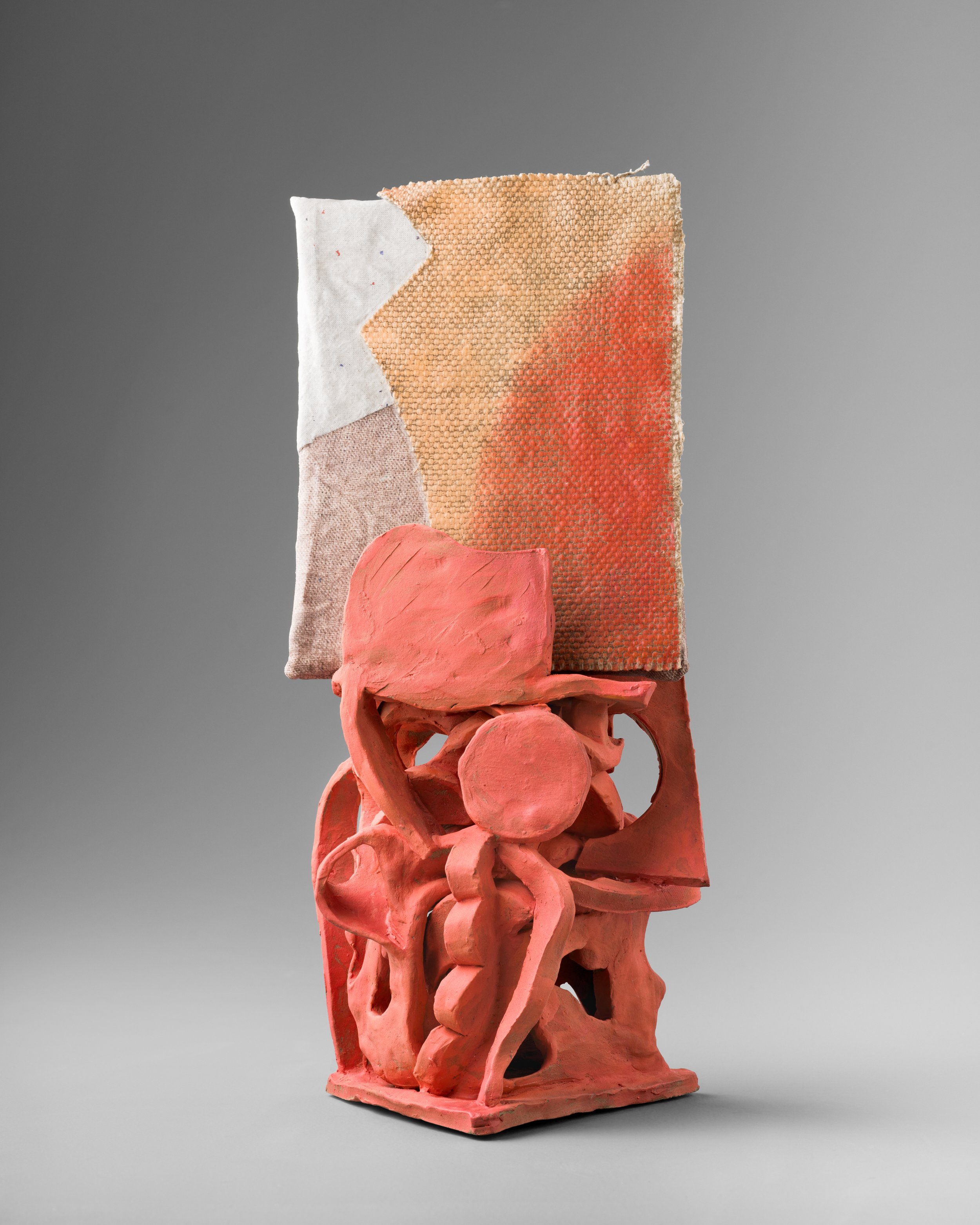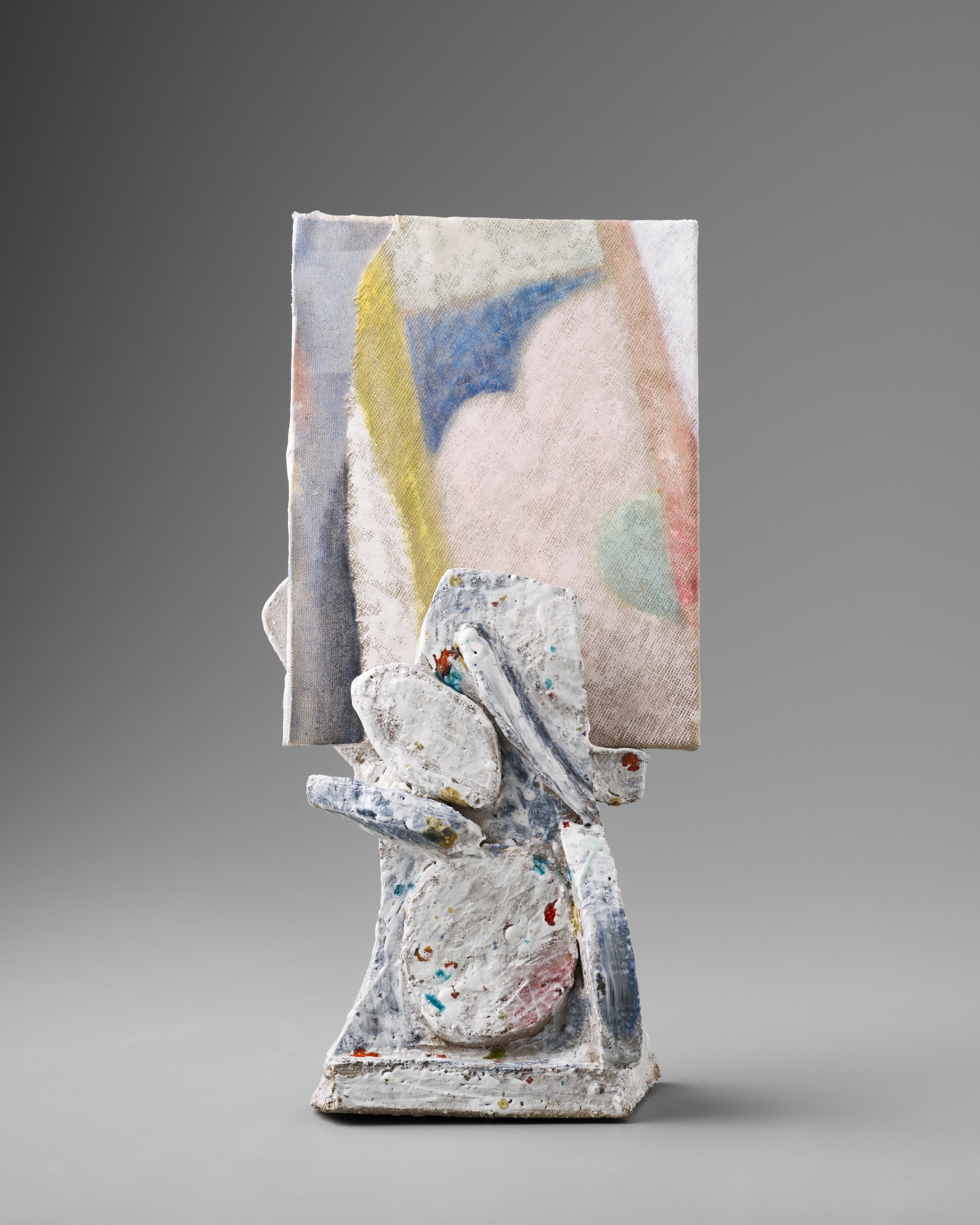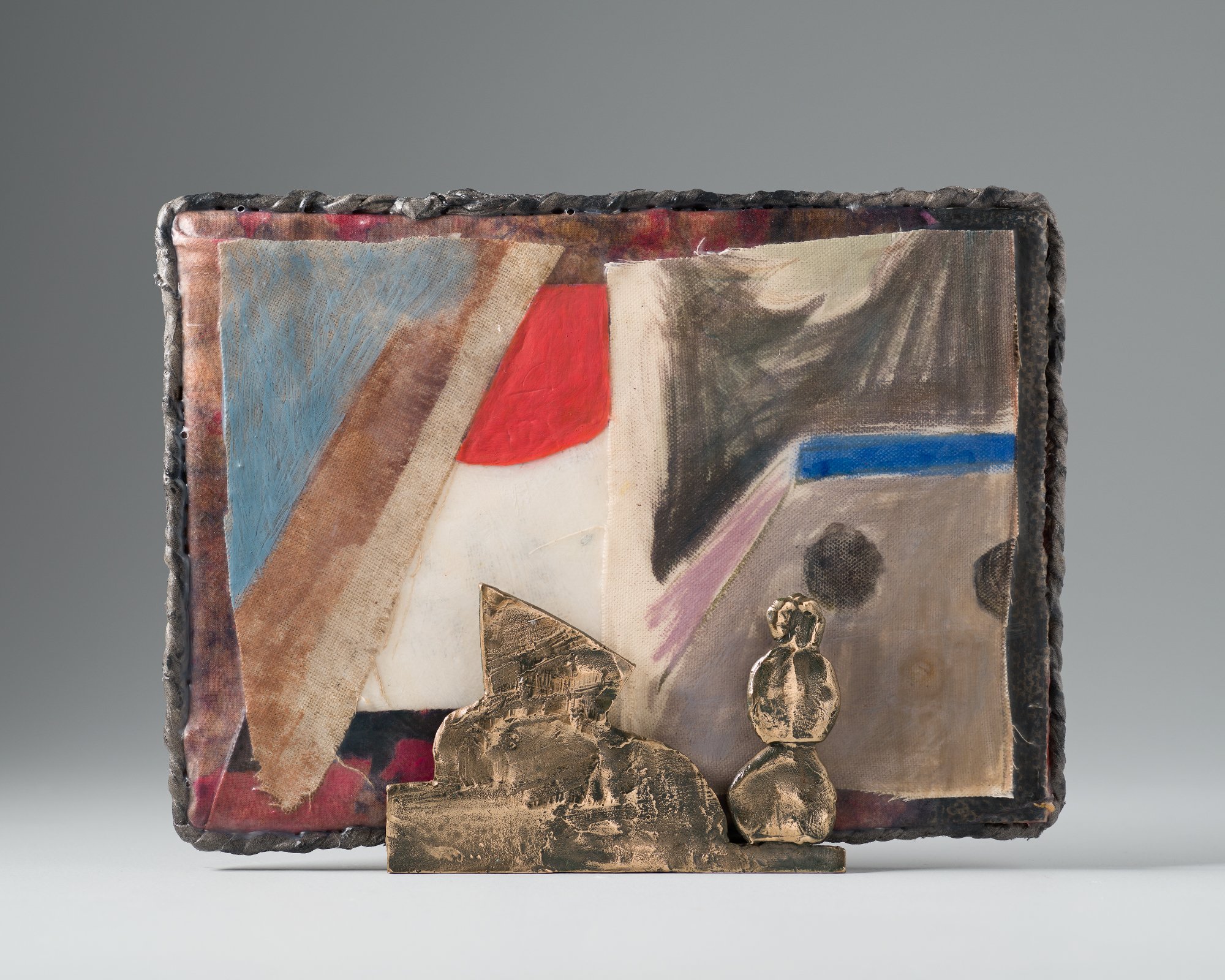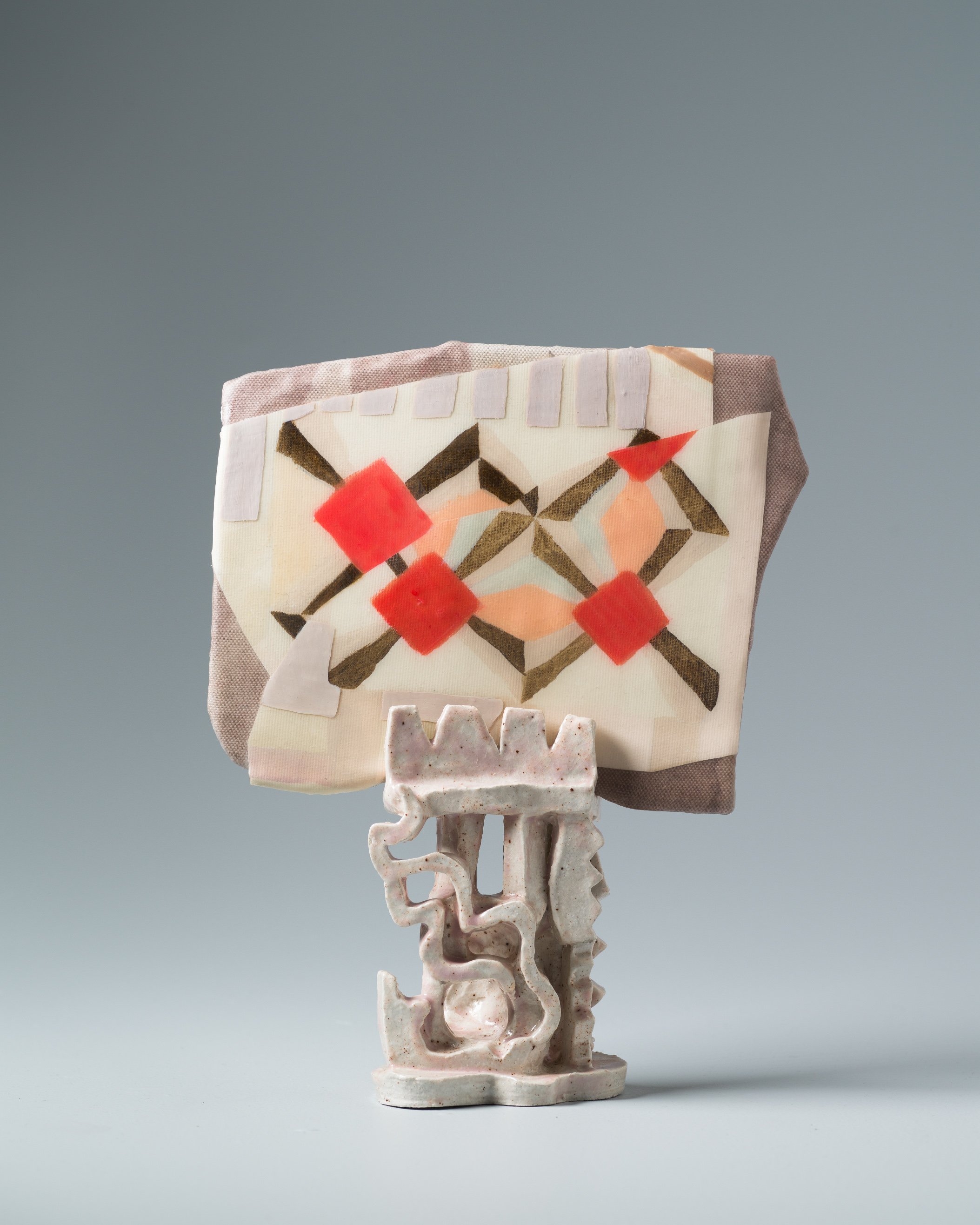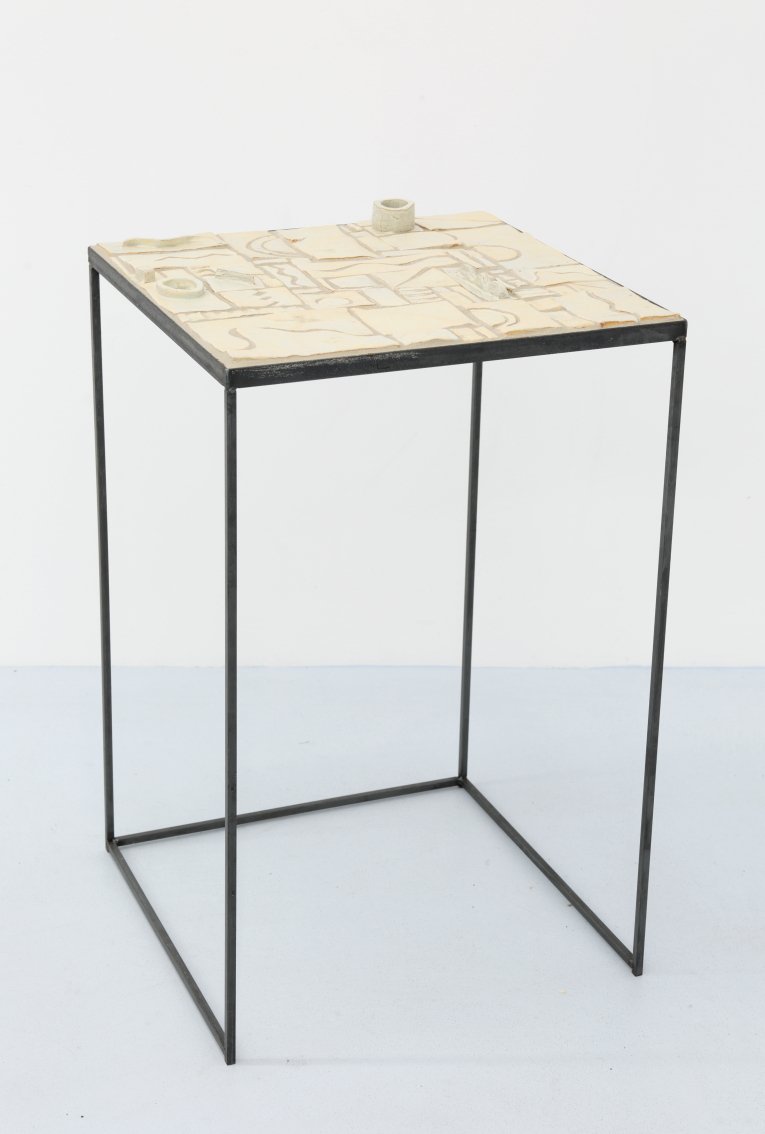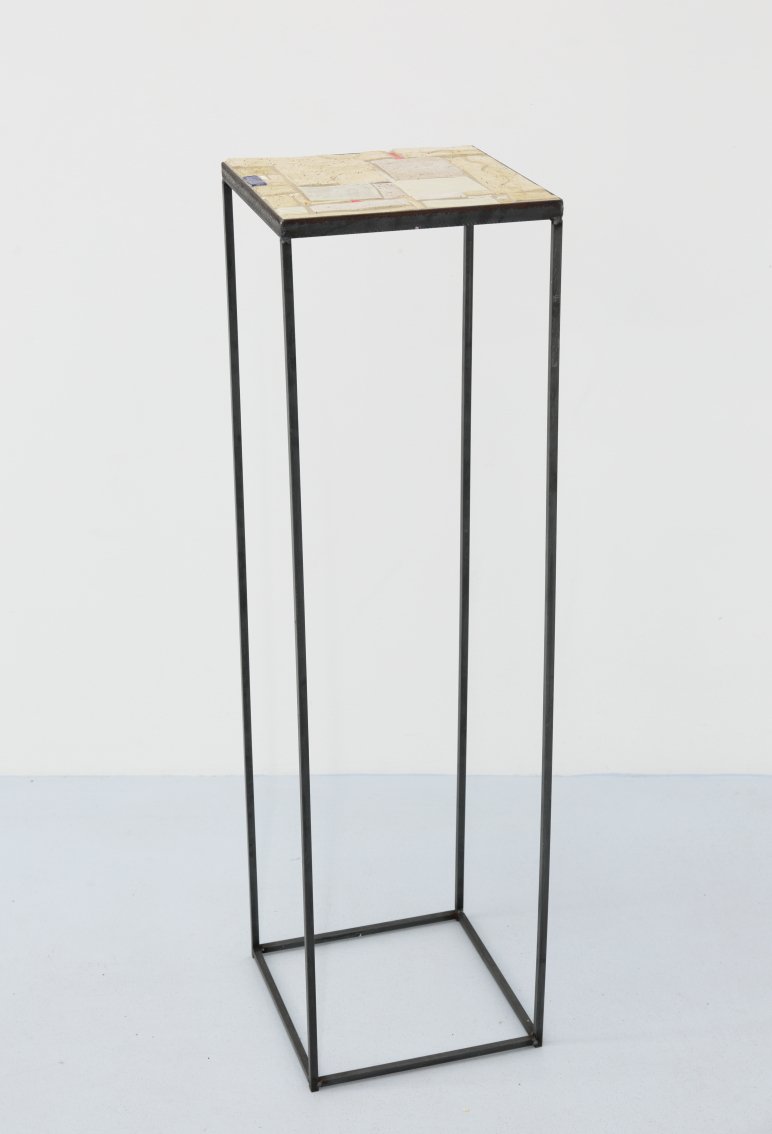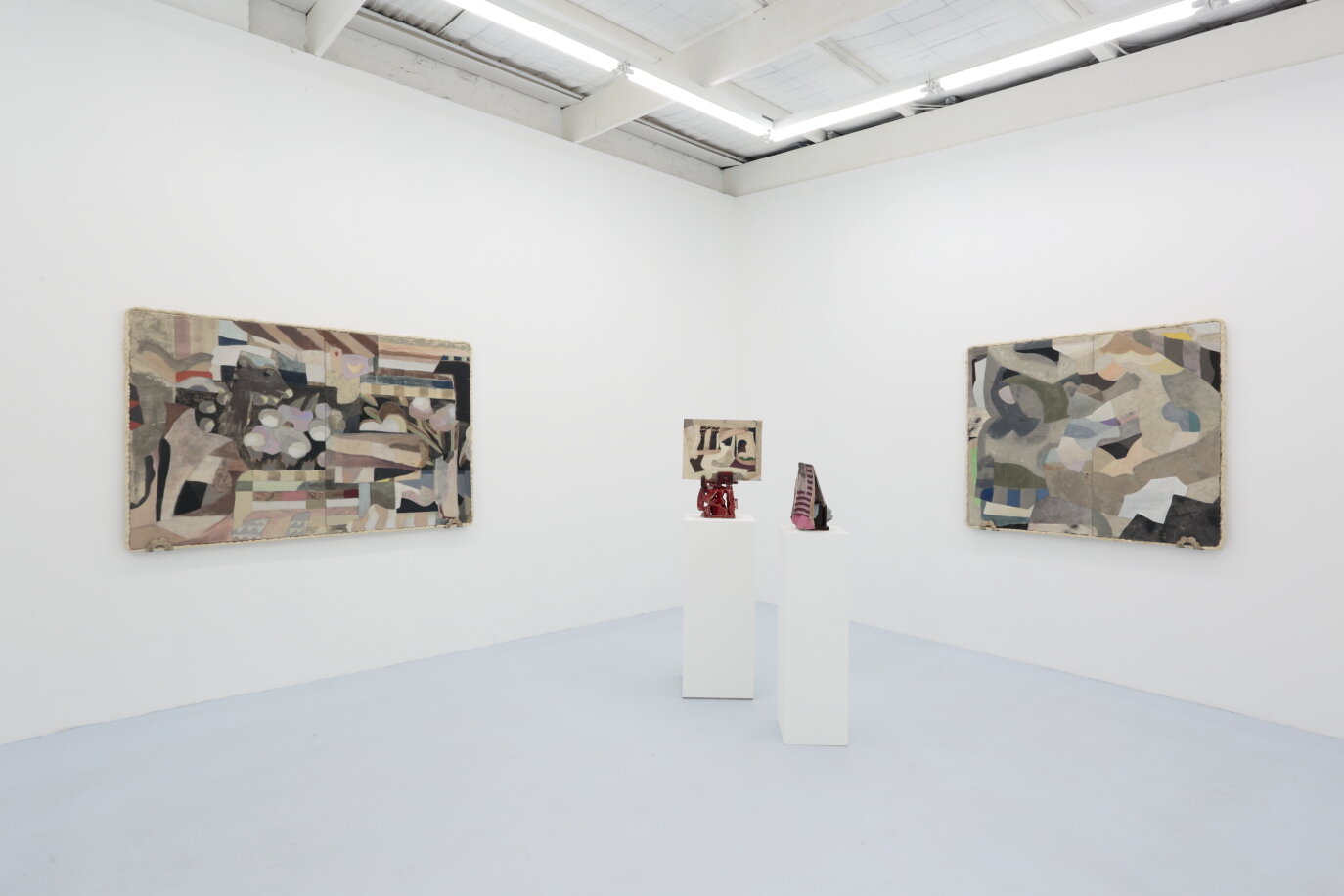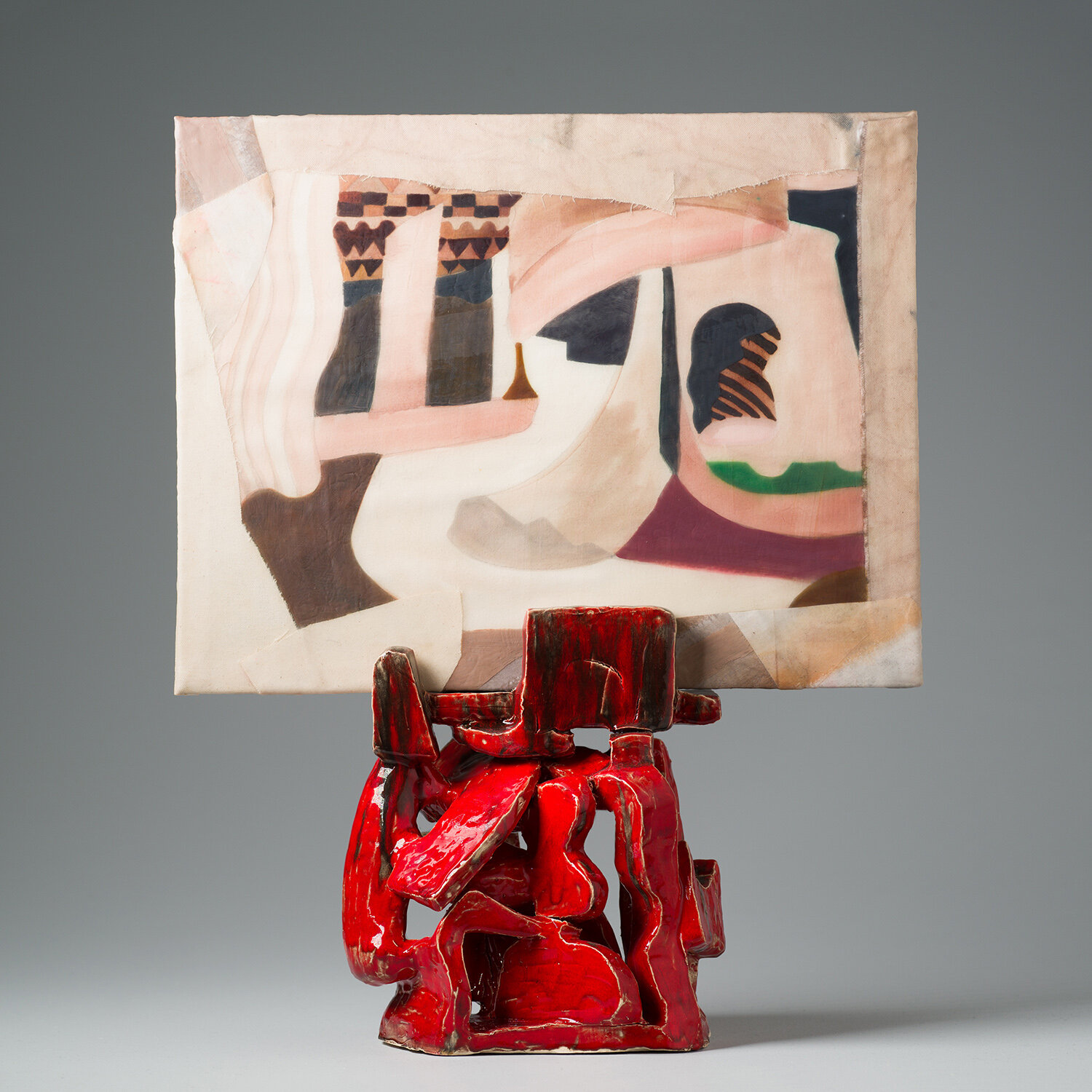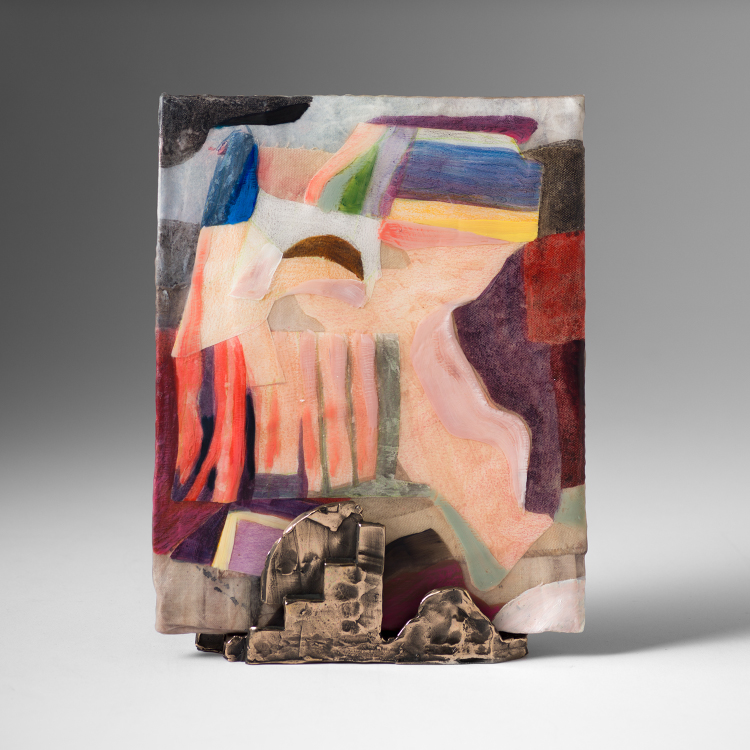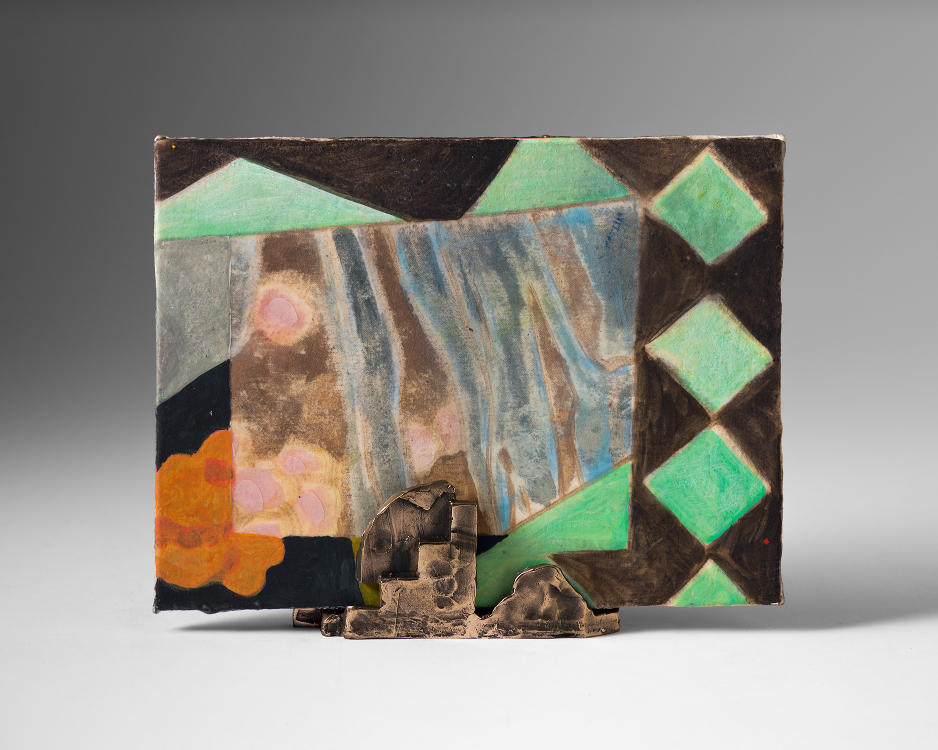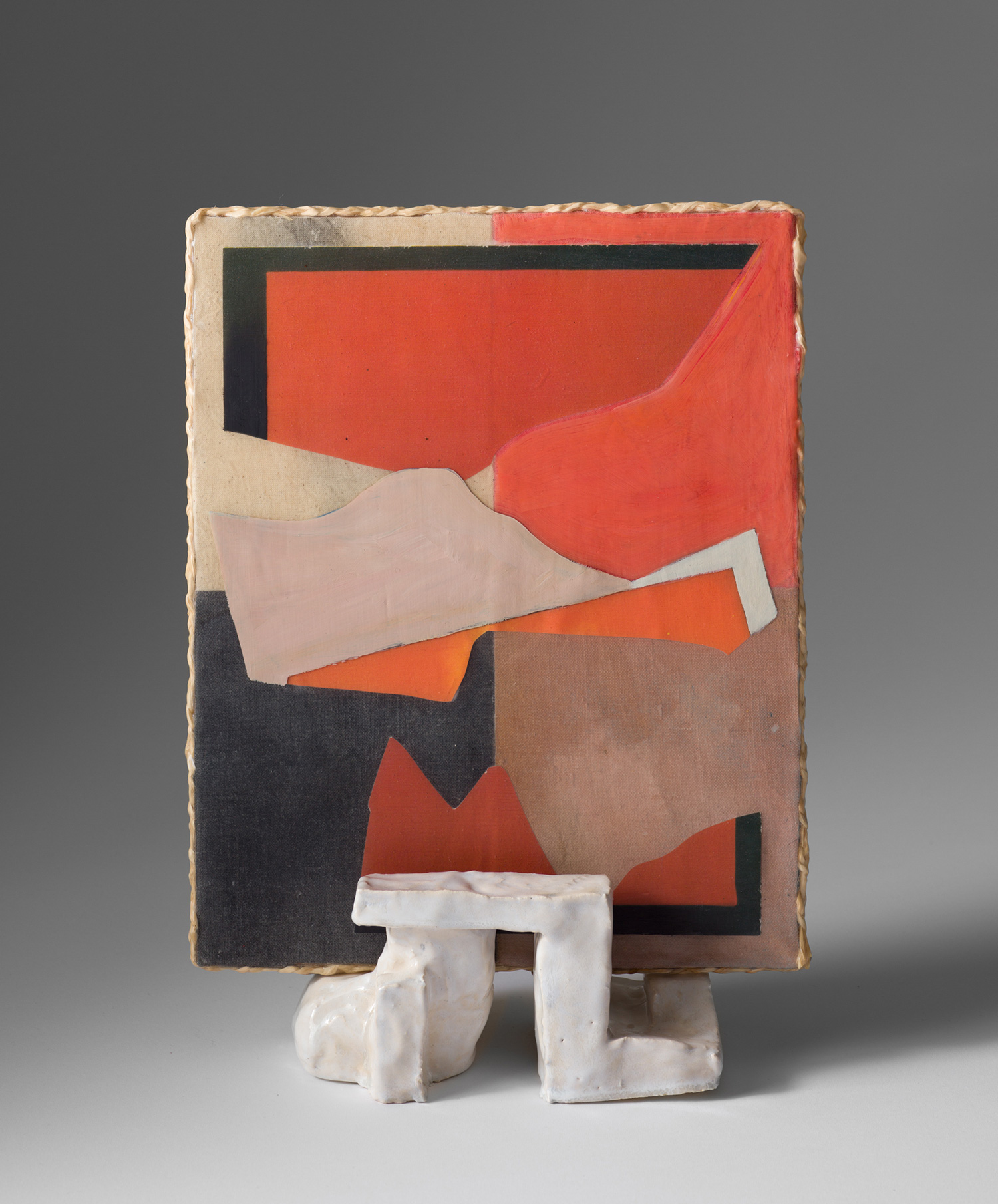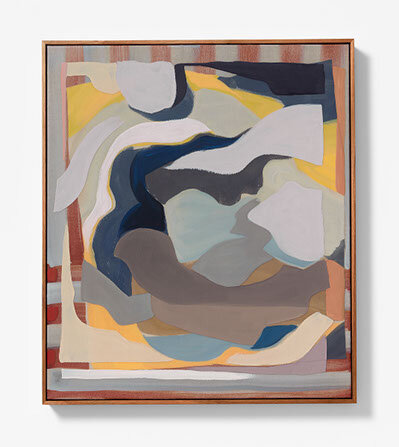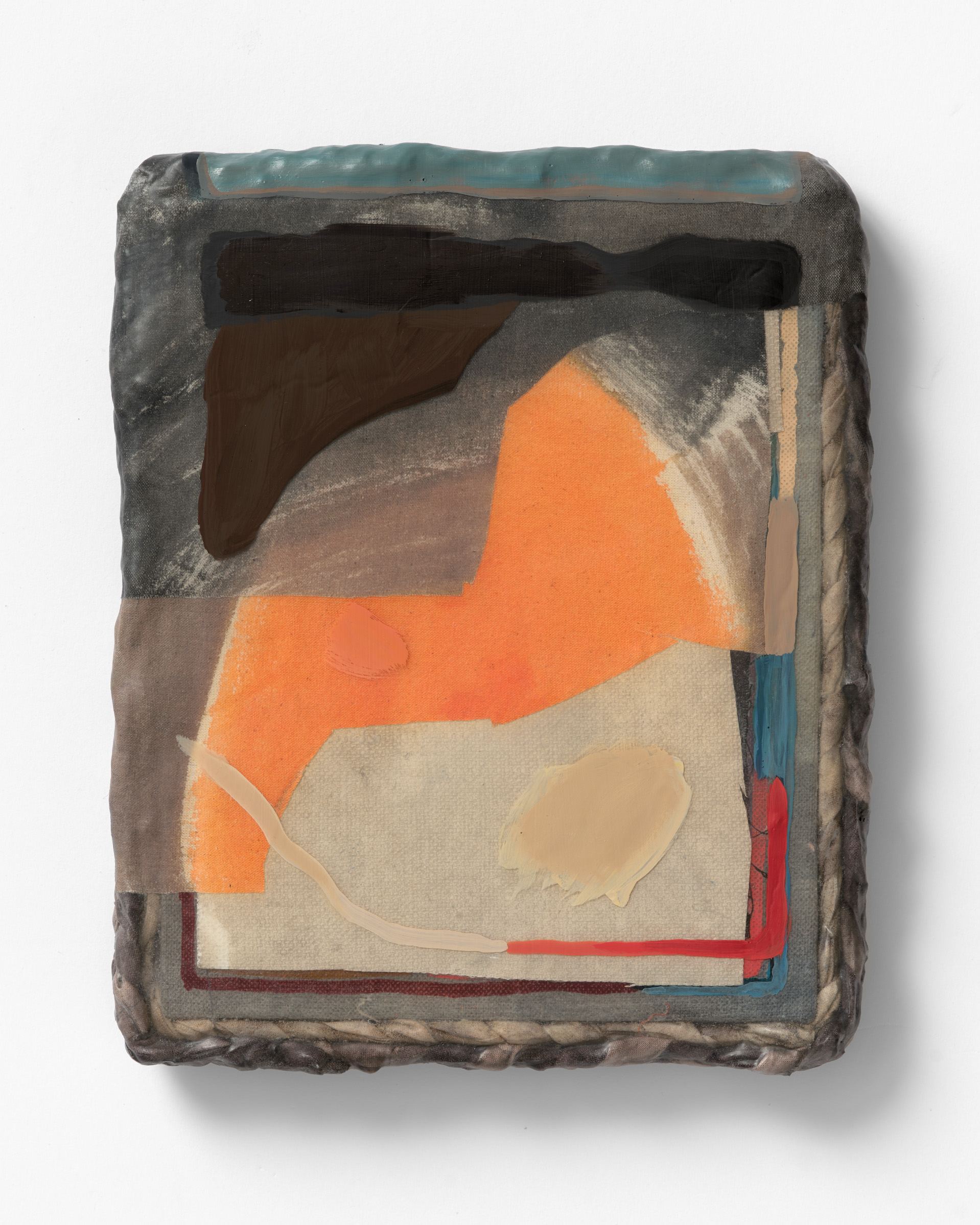Kate Tucker
Kate Tucker’s paintings shift and fracture then recombine elements in a manner that subverts expected order. Materials are manipulated so as to maintain a rawness and familiarity whilst taking on foreign characteristics. The result is a compression of stuff, physical and pictorial, where traits are swapped and shared, and the painting is located through rather than onto the surface.
Tucker’s recent painting process has shifted towards building slab-like substrates through repetitive layering of various materials. This process emerged as a reaction to the restrictions of painting traditionally onto pre-stretched linens. Rather than working within a defined area and surface, each layer became an opportunity to change the form as well as the content of the work. The result is a series of ‘tablets’ – irregularly shaped paintings that represent an accumulation of numerous material based experiments, rather than the realisation of a pre-conceived idea. The freedom afforded by this has impacted on the way Tucker uses paint to form compositions and make marks. As paint is used to stain calico, which is then wrapped and plaited around the substrate, any painting that is done with a brush must co-habit with a different iteration of itself. Similarly, fabrics that are digitally printed with images of other works are used, sometimes images of earlier versions of the actual painting they become part of.
The ambition to marry or equalise opposing elements points back to the conundrum of making paintings in the digital age. Tucker has been attempting to transfer some of the opportunities of digital mediums across to painting and has chosen to do this through process rather than visual cues. In these works elements may be stripped of context and casually combined, but unlike in Photoshop, the physicality of the materials means the painting grows with every layer. The ambiguity of the finished surface is difficult to translate through photography, which adds a final iteration to the loop of analogue and digital.
-
Kate Tucker is a Melbourne/Naarm-based artist. Her recent projects include solo exhibitions at Daine Singer, Cathedral Cabinet, Bus Projects, Galerie Pompom, Art Stage Singapore, Chapter House Lane, c3 Contemporary Art Space, Platform and Helen Gory, and group exhibitions at NADA New York, Sutton Projects, Dutton Gallery, Bendigo Art Gallery, Caloundra Regional Gallery, Castlemaine Art Museum, Swan Hill Regional Gallery, Ararat Gallery TAMA, McClelland Sculpture Park + Gallery, Murray White Room, La Trobe Art Institute, Geelong Gallery, Penrith Regional GalleryCaves, Tristian Koenig, SPRING1883, Incinerator Gallery, Bus Projects and LON Gallery. Tucker is recipient of the 2022 Sunshine Coast Art Prize, and has been a finalist in the Arthur Guy Memorial Painting Prize, Len Fox Painting Prize, Geelong Contemporary Art Prize, The Substation Prize, Albany Art Prize, Bayside Acquisitive Art Prize, The Churchie Emerging Art Prize, Geelong Acquisitive Print Awards, and The Archibald Prize. Her work is held in collections including Artbank, Shepparton Art Museum and Bendigo Art Gallery. Tucker graduated from the Victorian College of the Arts in 2009.
In 2024 Perimeter Editions published A community of parts, a monograph on Tucker’s evolution of practice over the last decade.
-
-
-
Kate Tucker (b.1980 Canberra, lives Melbourne/Naarm)
Education
2009 Graduate Diploma in Visual Art, Victorian College of the Arts
2008 Graduate Certificate in Visual Art, Victorian College of the Arts
2000-2003 Bachelor of Design in Multimedia Design, Swinburne UniversitySolo exhibitions
2024 Oddments, Daine Singer, Melbourne
2024 A community of parts, Daine Singer, Melbourne
2023 Fingerbreadth, Daine Singer, Melbourne
2022 Archive of colours / hierarchy of needs, Cathedral Cabinet, Melbourne
2021 A roof, not a room, Daine Singer, Melbourne
2020 Held, Daine Singer, Melbourne
2018 Manifold, Daine Singer, Melbourne
2017 Cuttings, Bus Projects, Melbourne
2016 Tablets, Daine Singer, Melbourne
2016 Unstory, Galerie Pompom, Sydney
2016 Cutaway, Chapter House Lane
2014 Emblem, c3 Contemporary Artspace, Melbourne
2014 Unstable Elements, Helen Gory Galerie, Melbourne
2014 Self similar, Rubicon ARI
2013 Recent Work, Helen Gory Galerie at Art Stage Singapore
2012 Viewfinder, Helen Gory Galerie, Melbourne
2011 Warmth and water, Platform Public Contemporary Art Spaces, MelbourneGroup exhibitions
2024 Melbourne Art Fair
2023 Expressive potential: studies in abstraction, Bendigo Art Gallery, Victoria
2023 Daine Singer at Darren Knight Gallery, Sydney
2022 Future Fair (New York) Holiday Market on Artsy, online
2022 Artist Seeking Collector, Res Artis, Melbourne
2022 Sunshine Coast Art Prize, Caloundra Regional Gallery
2022 Text Tile, Caves, Melbourne
2022 O Horizon, Salamanca Arts Centre, Hobart
2022 Len Fox Painting Prize, Castlemaine Art Museum
2022 Notions of Care, Swan Hill Regional Gallery & Ararat Gallery TAMA
2022 Melbourne Art Fair, Melbourne
2021 Four X Four, McClelland Sculpture Park + Gallery
2021 Arthur Guy Memorial Painting Prize, Bendigo Art Gallery
2021 Notions of Care, Bus Projects, Melbourne
2020 Daine Singer at FAIR PRESENTED BY NADA
2020 Daine Singer at Melbourne Art Fair, Melbourne
2019 Friends and Family, Daine Singer, Melbourne
2019 Notions of Care, HoBiennale, Hobart
2019 Winter Exhibition/Gallery Artists, Daine Singer, Melbourne
2019 Model, Murray White Room, Melbourne
2018 Support Structure, La Trobe Art Institute, Bendigo
2018 Geelong Contemporary Art Prize, Geelong Gallery, Geelong
2018 Daine Singer at NADA New York, USA
2018 Dutton Gallery at NADA New York, USA
2017 Young Moderns, Penrith Regional Gallery
2017 Materials, Collaborator, Virtual Reality Experience by Tom Crago, NGV Triennial
2017 Liquid Daydreams, Mailbox Artspace, Melbourne
2017 17/17 painting/not painting, Galerie Pompom
2017 Daine Singer at Spring 1883, Sydney
2017 Dutton Gallery (New York) at Spring 1883, Sydney
2017 Arthur Guy Memorial Prize, Bendigo Art Gallery
2017 A fabled Object, Byron School of Art, NSW
2016 Painting Revealed, Sutton Projects
2016 The Hunch, Incinerator Arts Complex 2016 Concrete Agenda, c3 Contemporary Artspace
2016 Palm Reader, LON Gallery
2016 Elastic Field, Strange Neighbour
2015 Dutton Gallery (New York) at Spring 1883, Sydney
2015 Percy Grainger: In the company of strangers, Bayside Arts & Cultural Centre
2015 MAN, Tristian Koenig Gallery
2015 Cave Painting - 1, Caves Gallery
2012 Symphonic Encounters, Linden Centre for Contemporary Arts
2010 Counterfeit Sanctity, C3 Contemporary Artspace, Melbourne
2009 Array, Bus Projects, MelbourneAwards
2024 Finalist, Len Fox Painting Award, Castlemaine Art Museum
2024 Finalist, Woollahra Small Sculpture Prize, Woollahra Gallery at Redleaf
2022 Winner, Sunshine Coast Art Prize, Caloundra Regional Gallery
2022 Finalist, Len Fox Painting Prize, Castlemaine Art Museum
2021 Finalist, Arthur Guy Memorial Painting Prize, Bendigo Art Gallery, Bendigo
2018 Finalist, Bayside Art Prize
2018 Finalist, Geelong Contemporary Art Prize
2018 Shortlisted, Perimeter Small Book Prize
2017 Finalist, Arthur Guy Memorial Painting Prize, Bendigo Art Gallery
2016 Finalist, Substation Contemporary Art Prize
2016 Finalist, Geelong Contemporary Art Prize
2015 Finalist, Albany Art Prize
2015 Finalist, Bayside Acquisitive Art Prize
2014 Finalist, The Churchie Emerging Art Prize
2013 Finalist, Geelong Acquisitive print Awards
2013 Shortlisted, 100 Painters of Tomorrow, Thames & Hudson
2012 Finalist, The Churchie Emerging Art Prize 2012 Finalist, The Archibald PrizeSelected bibliography
2025 Kate Tucker, NAS Art Forum lecture, Sydney
2024 Kate Tucker, A community of parts, Perimeter Editions, Melbourne 2024
2022 Karina Dias Pires, Artists at Home, Thames and Hudson, October 2022
2021 Art Guide Australia Podcast, Notions of Care #1, Kate Tucker with Tiarney Miekus
Charlotte Cornish, ‘Small details intimately observed’, A roof, not a room, cat. essay, Daine Singer, 2021
2021 Amelia Wallin, Held, cat. essay, Daine Singer, 2021
2018 ‘NADA New York 2018 the best we’ve seen’, Metal Magazine, March 2018
2017 Laura Bannister, 'Interview with Kate Tucker', Museum Magazine, October 2017
2017 Sally Groom, 'The State of Painting', Art + Australia Online, 2017
2017 Laura Couttie, 'Kate Tucker - Cuttings' catalogue essay, Bus Projects, Melbourne, 2017
2017 Amelia Winata, 'Kate Tucker - Tablets' catalogue essay, Daine Singer, Melbourne, 2017
2016 Dan Rule, Our pick of what’s showing at the galleries, The Age, Saturday 30th January 2016
2014 Phip Murray, Shifting Ground - Artist Profile, Australian Art Collector July-September 2014
2014 RRR Smartarts, Art Attack Review, Richard Watts, Tai Snaith & Ace Wagstaff, 10 July 2014
2014 Lee Tran Lam, Kate Tucker Artist Profile, Inside Out Magazine, May/June 2014
2013 Phip Murray, ‘Collectors Love’, Australian Art Collector, Jan-March 2013Collections
Artbank
Shepparton Art Museum
Bendigo Art Gallery
Bowerman Collection
Melbourne Art Collective













